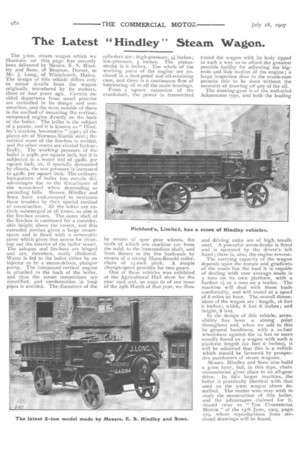The Latest " Hindley " Steam Wagon.
Page 6

If you've noticed an error in this article please click here to report it so we can fix it.
The 3-ton, steam wagon which we illustrate on this page has recently been delivered by Messrs. E. S. Hindley and Sons, of Bourton, Dorset, to Mr. J. Long, of Whitchurch, Hants. The design of this vehicle differs only in minor details from the wagon originally introduced by its makers, three or four years ago. Certain decided departures front usual practice are embodied in its design and construction, and the most notable of these is the method of mounting the verticalcompound engine directly on the back of the boiler. The boiler is the subject of a patent, and it is known as " Hindley's stayless, locomotive " type ; all the
plates are of Siemens-Martin steel ; the vertical seam of the fire-box is welded, and the other seams are riveted hydraulically. The working pressure of the boiler is 2251b. per square inch, but it is subjected to a water test of 35o1b. per square inch, or, if specially demanded by clients, the test pressure is increased to 45o1b. per square inch. The ordinary loco-pattern of boiler has certain disadvantages due to the disturbance of the water-level when descending or ascending hills. Messrs. Hindley and Sons have endeavoured to overcome these troubles by their special method of construction. All the tubes are entirely submerged at all times, as also is the fire-box crown. The outer shell of the fire-box is continued for a considerable height above the crown, and this extended portion gives a large steamspace and is fitted with a removable oover which gives free access for cleaning out the interior of the boiler vessel. The ash-pan and fire-bars are hinged and are, therefore, easily clinkered. Water is fed to the boiler either by an injector or by a steam-driven, plunger pump. The compound-vertical engine is attached to the back of the boiler, and thus the steam connections are simplified, and condensation in long pipes is avoided. The diameters of the
cylinders are : high-pressure, 31 inches ; low-pressure, 5 inches. The pistonstroke is 6 inches. The whole of the working parts of the engine are enclosed in a dust-proof and oil-retaining case, and there is a continuous flow of lubricating oil to all the main bearings. From a square extension of the crankshaft, the power is transmitted by means of spur gear wheels, the teeth of which are machine cut from the solid, to the intermediate shaft, and from thence to the live back-axle by means of a strong Hans-Renold roller_ chain of 2,1-inch pitch. A simple change-speed provides for two gears.
One of these vehicles was exhibited at the Agricultural Hall show for the year 1906 and, on page 61 of our issue of the 29th March of that year, we illus
trated the wagon with its body tipped in such a way as to afford the greatest possible facility for adjusting the bigends and link motion of the engine; a large inspection door in the crank-case permits this to be done without the necessity of drawing on' any of the oil.
The steering-gear is of the well-tried Ackermann type, and both the leading and driving axles are of high tensile steel. A powerful screw-brake is fitted and is operated by the driver's left hand ; there is, also, the engine reverse.
The carrying capacity of the wagon depends upon the nature and gradients of the roads but the load it is capable of dealing with over average roads is 3 tons on its own platform, with a further rl or 2 tons on a trailer. The machine will deal with these loads comfortably, and will travel at a speed of 8 miles an hour. The overall dimensions of the wagon arc : length, 16 feet 6 inches ; width, 6 feet 6 inches; and height, 8 feet.
In the design of this vehicle, accessibility has been a strong point throughout and, when we add to this its general handiness, with a to-foot wheel-base against the 12 feet or more usually found on a wagon with such a platform length (12 feet 6 inches), it will be admitted that this is a vehicle which should be favoured by prospective purchasers of steam wagons. Messrs. Hindley and Sons also build a 5-ton lorry, but, in this type, chain transmission gives place to an all-gear drive. In this larger machine, the boiler is practically identical with that used on the 3-ton wagon above described. The reader woo may wish to. study the construction of this boiler, and the advantages claimed for it, 0-mulct refer to " Tiix COMMERCIAL MOTOR" of the r5th June, 1905, page. 279, where reproductions from sectional drawings will be found.


























